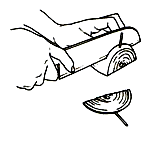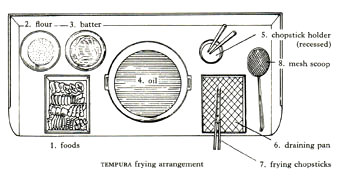Ingredients:
- 4-8 medium shrimp
- 6-inch (15cm) piece raw squid
- 4-8 small sillago (kisu) fillets, or fillets of small white-fleshed fish
- 2-3 medium onions
- 4-5 inches (10-13cm) lotus root
- 4-8 shiitake mushrooms or white mushrooms, wiped and trimmed
- 1-2 sweet potatoes
- 4-8 shiso leaves
- 15-16 stalks trefoil
- dipping sauce:
- 1 cup dashi
- 1/3 cup mirin
- 1/3 cup light soy sauce
- 1 cup grated giant white radish (daikon oroshi)
- few tsps finely grated fresh ginger
- batter:
- 2 egg yolks
- 2 cups ice water
- 2 cups sifted flour
- oil for deep frying
4 servings
The classic "batter-fried" food in Japan is tempura, which is no stranger to the West. What is not well known about this so-called typical Japanese dish is that in actual fact it was introduced, or at least devised, centuries ago by Europeans living in Japan - the Spanish and Portuguese who established missions in southern Japan in the late sixteenth century. The dish caught on with the Japanese, who added the thin, delicately seasoned dipping sauce with grated daikon mixed in. By now tempura has passed so thoroughly into native cooking that its origin is almost forgotten.
While tempura remains an exclusive domain of tempura specialty restaurants, it is also easy enough to make at home with very good results. In its higher forms it is a food reserved for special occasions, in its more pedestrian forms, simply a good meal. Whatever the purpose of the meal, to feast or to feed, in making tempura the cook should observe three points - fresh ingredients, oil at a constant temperature, and lumpy batter. The reasons behind using the freshest fish and vegetables available are self-evident. Keeping oil at a constant, proper temperature means even frying, and precise control, and light food, as discussed in detail above. But perhaps lumpy batter as a sine qua non for good tempura requires further explanation.
With tempura, the goal is to achieve a lacy, golden effect with the deep-fried coating, not a thick, armorlike pancake casing. To avoid a heavy, oily-tasting coating, do the opposite of all that you would do to make good pancakes. Make the tempura batter just before you are ready to begin deep-frying. Do not let the batter stand. In fine tempura restaurants, for instance, batter is made in small batches as orders come in. Tempura batter should never be mixed well. It should not be smooth and velvety. It should be only loosely folded together (with chopsticks, which are not an efficient tool for mixing and hence the perfect utensil for this job). The marks of good tempura batter are a powdery ring of flour at the sides of the mixing bowl and a mixture marked with lumps of dried flour.
Important. Make sure all foods to be coated are thoroughly dry (pat dry with toweling if necessary) and then dredge lightly in flour (except nori, shiso leaves, and knotted trefoil). This flour coat allows the batter to adhere well to the food.
Depending on how much lacy, golden coating you like on your tempura, you may adjust the coating technique and the consistency of the batter. If you like a thick coating, make a thick batter using slightly less ice water than in the recipe below. Much batter will adhere, and the coating will be thick. For the thinnest coating possible, make a thin batter by using more ice water than indicated below and gently shake dipped items over the batter bowl so excess batter returns to the batch.
Seasonal fish and vegetables are used in tempura. The ingredients for tempura in the recipe below are only a few of the many, many common ingredients that lend themselves to this treatment. Shrimp; squid; small whole fish like perch, smelt, and goby; white-fleshed saltwater fish; eggplant; green beans; onion rings; sweet potato slices; bell pepper strips; mushrooms - the list could go on for several pages. Chicken, beef and pork, however, are not usually prepared as tempura because of their relatively heavier, identifiable taste. Chicken and pork are deep-fried in other ways, and beef is often given a more highlighted preparation, say, in sukiyaki.
Soup and pickles accompany tempura. Beverages should be sake, beer, or tea. Hot rice and more pickles conclude the repast.
Directions

To prepare: Shell and devein shrimp, but leave tails attached. Chop off the tips of shrimp tails and gently press out moisture from shrimp with the flat of the knife tip. To prevent shrimp from curling as they are deep-fried, make a few deep incisions along the belly, as shown, and then lightly tap across each shrimp with back of knife blade.
Cut squid into 1 1/2-inch (4cm) squares, then cross-score the outer, smooth side of each piece lightly.
Use the sanmai oroshi technique (pp 123-) for sillago or other small fish, but in this case stop the knife at the base of the tail and cut off and remove the central bone as close to the tail as possible. The result is 2 fillets attached to a tail. This may be tricky, and is mainly decorative anyway; it is no disaster if the fillets have no tails. Clean and pat dry sillago fillets. If you are using fillets of a large white-fleshed fish, remove bones and cut fillets crosswise into bite-sized pieces.

Pierce onions with toothpicks then cut into rounds, as shown, to keep rounds from falling apart into rings.
Scrape lotus root and slice into rounds. Place immediately in weak vinegar-water to prevent discoloration.
If mushroom caps are very large, cut in half.
Peel sweet potato and slice crosswise into rounds.
Wash and pat dry shiso leaves.
Hold 3 or 4 trefoil stalks together and tie into a knot just below leaves. Trim off stalks about 1 1/2 inches (4cm) below knot.
Prepare the dipping sauce by combining ingredients over heat and bringing just to a boil. Keep warm.
Grate radish and ginger.
To deep-fry: Make the batter in 2 batches, the first batch just before you are ready to begin deep-frying, as you are waiting for the oil to heat. In a mixing bowl, lightly beat 1 egg yolk, then pour in 1 cup of ice water and give this a few strokes. Add 1 cup sifted flour all at once. Stroke a few times with chopsticks or fork, just till ingredients are loosely combined. The batter should be very lumpy. If you overmix, the batter will be sticky and the coating will turn out oily and heavy. Mix the batter with the least amount of movement. Make the second batch of batter as the first is used up.
The oil should be fairly hot, about 340° F/170° C. Test by dropping a tiny bit of batter into the oil; it should descend slightly beneath the surface of the oil, then be buoyed up to the surface, the oil gently bubbling round its edges.

When you begin to deep-fry, set up the area around the heating unit like an assembly line: a tray or several trays of foods to be fried, a container of flour for dipping, and the batter bowl at your left; the hot oil pot at center; the rack for draining and skimmers and chopsticks and slotted spoons, at right. Try to arrange the physical layout and your timing to serve the tempura immediately after frying, but if you cannot, keep foods hot.
Each food item progresses through the assembly line in this way; use fingers to dip food in flour, shake off excess, then dip in batter; lay or slide coated material in hot oil and deep-fry till golden, around 3 minutes, turning in the oil for even cooking. Retrieve with slotted spoon or cooking chopsticks and briefly drain before transferring to serving plate. Skim the surface of the oil occasionally to keep it clean. Stir batter once or twice as you work, to keep it from separating.
Begin with vegetables, then move on to shrimp and fish or other foods that need a higher oil temperature.
There are exceptions to this flour- and batter-coating process - shiso leaves, nori seaweed and knotted trefoil are not dipped in flour and are batter-coated on the "back" side only. If these are completely covered with batter, their color or texture would be lost.
To serve: A bar-type arrangement that allows you to serve diners directly from the stove or from a deep-fryer at a sideboard is ideal for tempura. Diners should be provided with a plate or bamboo tray lined with absorbent paper on which tempura is placed as it is done. If, on the other hand, you have to bring the deep-fried food from kitchen to table, arrange 8 or 10 pieces of tempura (2 shrimp, 2 fish, and several vegetables) on paper-lined places or trays and serve that way.
At the table, pour hot dipping sauce into a small bowl, mix in grated daikon and a bit of grated ginger, if desired. Dip tempura in this sauce and eat.

Reprinted with permission from the book:
Japanese Cooking: A Simple Art
Kodansha International
Easily the most comprehensive and exhaustive look at Japanese cuisine available, this groundbreaking classic marks its quarter-century anniversary in a revised edition with a new foreword by Gourmet editor-in-chief Ruth Reichl and a new preface by the late Tsuji's son, Yoshiki Tsuji.
Part cookbook, part philosophical treatise, this highly acclaimed collection offers a wealth of insight for amateurs and experts alike. Every technique associated with Japanese food is described step by step in great detail, along with illustrations to guide the reader through everything from filleting fish or cleaning an octopus to rolling omelets.
Sections on the Japanese meal, ingredients and selecting and cutting fish, chicken and vegetables offer great insight into the culture as well as the food. The recipe section of the book is divided by cooking method rather than food type, including grilled and pan-fried, steamed, simmered and deep-fried.
Dishes range from the simple, Pan-Broiled Salmon, to the more complex, Nagasaki-Style Braised Pork, and many dishes are vegetarian. Sushi and sashimi are covered in depth, as are knives, the proper way to slice the fish, and decorative presentations.
A complete guide to Japanese cooking, this collection is must-have for anyone interested in Japanese food or culture.
ISBN 978-4770030498
Y4800
- Order this book from amazon.com
- Order this book from amazon.co.jp (in Japan)
- Find this book at your local English-language bookstore in Japan
- Or use the ISBN to order from your local bookstore.








